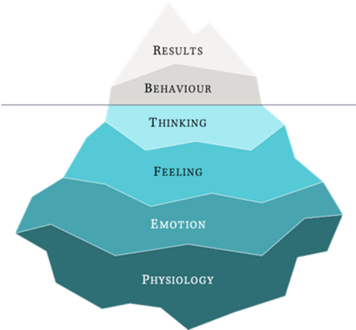
When was the last time you had a pressure-free day? Many of us can perform well when the pressure is off, but how often does that happen?
For most people in senior positions, it’s always showtime. The thing many people don’t realise is that what’s on show is fundamentally driven by what’s inside. And that the right coaching can reach the inside to influence the outside. Let me explain …
After 12 years in TV news presenting and 10 years coaching hundreds of execs to better performance, I’ve learned that there are two, inextricably linked parts to performance. First, the outer aspects; the content and structure of a presentation, how to stand, ask questions and do the ‘power pose’. That first part gets lots of attention from coaches and trainers. But they often fail to pay attention to the second, inner aspect of performance – how we feel. The pressure of performance makes us feel a certain way and that directly affects our outer ‘show’.

Uncovering performance through coaching
To really understand the depths of that inner aspect of performance, take a look at the middle of this iceberg diagram. How you feel – nervous, anxious, terrified – is the label we apply to an emotion. An emotion is a ’pattern’ of energy – the sweaty palms, pounding heart, churning stomach that we’ve all experienced when we’re under pressure. And what drives that emotional response? Our physiology, literally the data from all the organs and systems of our bodies. All of that underpins what we think. And what we think drives our behaviour and the results, or performance, that we can achieve.
So, let’s get right into that inner aspect of our performance to help us perform brilliantly under pressure. We monitor physiology via the organ that gives off the largest electrical signal in the body – our heart. A healthy heart rate has a natural variation (within certain limits) – this is called heart rate variability (HRV). Generally, the greater the variability the better.
HRV and its impact on performance
Heart rate is very closely linked to the physical expression of feelings. Think about phrases like; ‘my heart pounded with excitement’ or ‘I love my husband with all my heart’. However, the patterns within the variability tell the real story. When we feel anxious, angry, stressed, or depressed, for example, our HRV tends to be chaotic.
There are a number of consequences of chaotic HRV and one is that our brain’s frontal lobes, that control things like motor function, problem solving, spontaneity, memory, language, initiation, judgement, impulse control, and social behaviour, ‘take a break’. In short, we essentially lobotomise ourselves. When the pressure is on and our HRV becomes chaotic we just can’t think as clearly as we did before and our performance suffers.
Coaching for cardiac coherence
By contrast, when we embody positive feelings such as enjoyment, happiness, love and excitement, our HRV tends to be rhythmic and ordered. This is known as cardiac (heart) coherence. In that state, we have greater control of our frontal lobes and we are able to perform at a much higher level. Unfortunately, you can’t take a pill to make your heart more coherent but you can train yourself and monitor your progress everyday via an app and earpiece.
Focusing on that fundamental aspect of performance – our physiology – helps influence all of those other parts of the ‘iceberg’. Get that right and pressures melt away. That’s where great coaching comes in. With the right coaching you can improve your cardiac coherence and perform at your best, even in the most pressurised situations.
In future blogs, I’m going to explore the other areas of the iceberg and show how performance under pressure is not only about our inner selves and what we do, but also about how we relate to others.